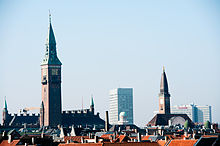Economy of Denmark

|
|
| Currency | Danish krone (DKK, kr) = 0.15 USD |
|---|---|
| calendar year | |
|
Trade organisations
|
EU, OSCE, WTO, OECD and others |
| Statistics | |
| GDP |
|
|
GDP growth
|
|
|
GDP per capita
|
|
|
GDP by sector
|
agriculture: 4.5%; industry: 19.1%; services: 76.4% (2011 est.) |
| 0.5% (2014) | |
|
Population below poverty line
|
N/A |
| 24.7 (List of countries) | |
|
Labour force
|
3 million (2015) |
|
Labour force by occupation
|
agriculture: 2.5%; industry: 20.2%; services: 77.3% (2005 est.) |
| Unemployment | 3.9% (August 2014) |
|
Average gross salary
|
466,000 DKK, 62,000 € / 70,000 $, annual (2015) |
| 277,000 DKK, 37,000 € / 42,000 $, annual (2015) | |
|
Main industries
|
List
|
| 3rd (2017) | |
| External | |
| Exports | $0.09 trillion (2009 est.) 33rd |
|
Export goods
|
|
|
Main export partners
|
|
| Imports | $0.09 trillion (2009 est.) |
|
Import goods
|
List
|
|
Main import partners
|
|
|
Gross external debt
|
$0.6 trillion (30 June 2009) |
| Public finances | |
| 44.5% of GDP (2014) | |
| Revenues | $0.2 trillion (2015 est.) |
| Expenses | $0.2 trillion (2015 est.) |
| Economic aid | ODA, $2.1 billion (2005) |
| AAA (Domestic) AAA (Foreign) AAA (T&C Assessment) (Standard & Poor's) |
|
|
Foreign reserves
|
$0.1 trillion (March 2011) |
|
|
![]() $0.3 trillion (2016) (nominal)
$0.3 trillion (2016) (nominal)
![]() $54,000 (2016) (nominal)
$54,000 (2016) (nominal)
Denmark has a diverse, mixed economy. It relies heavily on human resources, but not exclusively, as there are a few significant and valuable natural resources available, including mature oil and gas wells in the North Sea.Cooperatives form a large part of some sectors, be it in housing, agriculture or retail.Foundations play a large role as owners of private sector companies. Denmark's nominal GDP was estimated to be $333 billion, the 32nd largest in the world. It has one of the world's lowest levels of income inequality, according to the World Bank, but no legally stipulated minimum wage. As of January 2015 the unemployment rate is at 6.2%, which is below the Euro Area average of 11.2%. As of 28 February 2014 Denmark is among the countries with the highest credit ratings.
Denmark's main exports are: industrial production/manufactured goods 73.3% (of which machinery and instruments were 21.4%, and fuels, chemicals, etc. 26%); agricultural products and others for consumption 18.7% (in 2009 meat and meat products were 5.5% of total export; fish and fish products 2.9%). Denmark is a net exporter of food and energy and since has the 1990s balance of payments surplus. The total value of service and merchandise exports in 2013 amounted to 54% of GDP, and imports in 2013 amounted to 49% of GDP. Notable among the service exports are container shipping. There is no net foreign debt as other countries owe more money to Denmark than Denmark owes to them, but because of large deficits due to increased unemployment levels the central government has increased its debt level since the end of September 2008, when it stood at 21 percent (gross debt) of GDP, according to the central bank - in accordance with the Eurostat EMU- gross debt numbers, which only take liabilities into account. (See below (Budgets)). Taking assets into account as well net debt of the central government was 11 percent. The public sector as a whole had net assets of 108 billion kroner in 2008. Within the European Union, Denmark advocates a liberal trade policy. Its standard of living is average among the Western European countries - and for many years the most equally distributed as shown by the Gini coefficient - in the world, and the Danes devote 0.8% of gross national income (GNI) to foreign aid. It is a society based on consensus (dialogue and compromise) with the Danish Confederation of Trade Unions and the Confederation of Danish Employers in 1899 in Septemberforliget (The September Settlement) recognising each other's right to organise, thus, negotiate. The employer's right to hire and fire their employees whenever they find it necessary is recognised. There is no official minimum wage (Danish: minimumsløn) set by the government; the minimum of wages (Danish: mindsteløn) is determined by negotiations between the organisations of employers and employees. Denmark produces oil, natural gas, wind- and bio-energy. Its principal exports are machinery, instruments and food products. The US is Denmark's largest non-European trading partner, accounting for around 5% of total Danish merchandise trade. Aircraft, computers, machinery, and instruments are among the major US exports to Denmark. Among major Danish exports to the U.S. are industrial machinery, chemical products, furniture, pharmaceuticals, Lego and canned ham and pork.
...
Wikipedia
